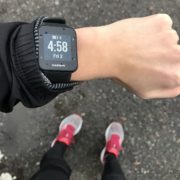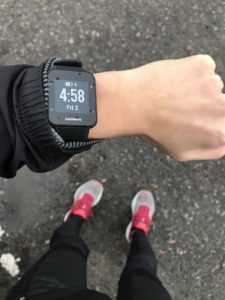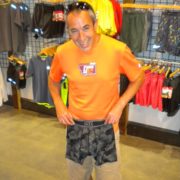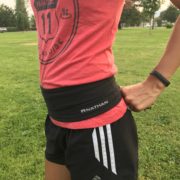Rachel Brumfield can be seen racing anything from the Resolution Run to Eleven Miles to Paradise, but also likes to explore and spends time in the mountains during the summer. You can follow her adventures on instagram @rachbrums. As a 2017/2018 RErun she gave us her review of her Garmin GPS watch.
I purchased my Garmin Forerunner 35 in the fall, mainly to avoid taking my phone on runs. Little did I know the incredible statistical possibilities that a smart watch would unleash. It’s helped motivate my running and has been a fantastic solution for my needs as a dedicated, yet pretty casual runner.
What it tracks: Steps, heart rate, running/walking distance (GPS), sleep, calories
Why it’s so great: In short, because it’s simple. I’m not a professional triathlete or an elite
ultramarathoner. I just need a wearable that will track my day-to- day fitness and clock my runs. Every once in a while, I’d like to know my splits – and the Forerunner 35 definitely keeps tabs on that (plus fastest mile, average cadence, heart rate, etc). But at the same time, I only have to remember how to use four buttons to get the job done.
-Built-in GPS – This is the main reason I invested in a watch. I wanted something that would track my daily activity with a specific emphasis on running. The built-in GPS frees me from my phone, allowing truly unplugged running without worrying I’ll totally lose track of time. It takes a max of 1-2 minutes to link and features five training modes: Run Outdoor, Run Indoor, Bike, Cardio and Walk.
-Long battery life – I can wear this daily for about a week before it needs a charge. Of course, this depends on how much you’re using the GPS tracker. I turn on the tracker for about an hour each day to clock my run. The packaging said it would last 9 days in watch mode and 13 hours in training (GPS) mode – I would say that’s pretty spot on.
-Durability – I love that the watch is waterproof (up to 50 meters). Not that I wear it frequently to swim, but I do not worry about wearing it while running in a downpour. Along the same lines, I have never had any issue with the Forerunner 35 in the cold. Unlike my iPhone, which shuts off frequently when exposed to Montana’s average winter temps, the watch plugs along, tracking with its usual accuracy.
-Wear-ability – As a small person, many smart watches just look downright unreasonable on my wrist. I think the Forerunner 35 is an appropriate fit. It’s not overtly stylish – but I like that it’s basic and doesn’t really draw any extra attention. Not a fashion accessory, but a fitness
accessory. It’s comfortable to wear all day, though I prefer to take it off at night.
– Connectivity – The Forerunner 35 connects to any smart phone via the Garmin Connect app.
While the app appears a bit unwieldy at first (the interface is not as clean as Fitbit or Apple
Health), it is very useful and houses an impressive amount of data – right down to average stride length and step cadence. The watch itself doesn’t have an altimeter, but once your run syncs to your phone, you get elevation stats. It also pushes notifications from your phone depending on your settings. For instance, you can read texts and get calendar reminders. And very helpfully, it buzzes when you get a phone call and allows you to accept or decline from the watch.
-Price – This may be the most compelling factor for the Garmin Forerunner 35. It has many of the useful features of an advanced GPS watch, but still comes in at just under $200. When
compared to Garmin’s other models or brands like Apple and Fitbit, it’s one of the best options
for features + price.
 Limitations: All that said, the Forerunner 35 does have a few drawbacks. It is a more basic smart watch, meaning it lacks some of the bells and whistles that more advanced models have. I’ve listed a few below, though none really affect my use of the watch.
Limitations: All that said, the Forerunner 35 does have a few drawbacks. It is a more basic smart watch, meaning it lacks some of the bells and whistles that more advanced models have. I’ve listed a few below, though none really affect my use of the watch.
-No altimeter. As described above, elevation information is added once the watch syncs with your phone. It’s pretty accurate, but not real time.
-No swim tracking. The Forerunner 35 is targeted toward runners, rather than triathletes or multi-sport athletes. Since it can be worn in the water, you could technically track your swim intervals through the “cardio” training mode, but if you need more specific metrics, you’d need to upgrade to one of Garmin’s more sophisticated models.
-Sleep and calorie tracking are questionable. As with most fitness trackers and smart watches, the algorithm for calories isn’t perfect and the sleep tracker is not accurate. Even with the heart rate tracker, I’ve had the Forerunner sense I was sleeping while I was watching a movie, etc.
Limited connectivity. You can’t pay for dinner using this watch nor can you respond to a text. For some, that’s a deal breaker – for me, the Forerunner 35 is sticking to what a watch should be (aka not a mini smart phone).
Summary: It’s a great little watch. For the average runner, the Garmin Forerunner 35 does everything you need it to – plus a little more – for about the same price as a pair of new running shoes. It won’t take you more than a couple of minutes to figure it out, and you’ll rarely stress about running out of battery or accidentally wearing it into the shower. But beware: you will gain access to more information about your runs/training – which, if you are just a touch competitive like me – could lead to caring more about your training, running just a little bit harder and possibly (dare I say!) improvement














